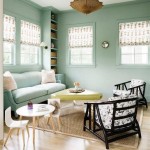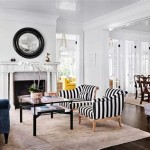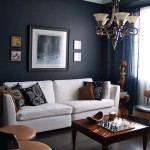Black And White Interior Design: Creating a Striking Living Room
Black and white interior design offers a timeless and versatile approach to creating a sophisticated and impactful living room. This color scheme, though seemingly simple, possesses the ability to evoke a range of emotions, from classic elegance to modern minimalism. The key to successful black and white design lies in understanding how to balance the elements, incorporate texture, and leverage the interplay of light and shadow to create a visually appealing and comfortable space.
The appeal of black and white stems from its inherent contrast. Black absorbs light and conveys a sense of depth, drama, and sophistication, while white reflects light, creating an airy, open, and clean atmosphere. This duality allows for a dynamic interplay, enabling the creation of both bold statements and subtle nuances within the design. The absence of color forces attention to the forms, textures, and spatial arrangements within the room, demanding careful consideration of each element.
When initiating a black and white living room design, the initial step involves determining the dominant color. Opting for primarily white walls and furniture with black accents cultivates a brighter and more spacious environment. Conversely, a predominantly black space with white accents evokes a more dramatic and intimate setting. The choice hinges on desired mood, the existing natural light within the room, and personal preferences.
Balancing Black and White: Proportions and Ratios
Achieving visual harmony in a black and white living room largely depends on establishing the appropriate proportions between the two colors. A common approach is to utilize a 60-30-10 rule. This involves allocating 60% of the space to the dominant color (typically white for its space-enhancing properties), 30% to the secondary color (black, often used for furniture and larger accent pieces), and 10% to a third accent color or texture to add visual interest and break the monotony.
The distribution of black and white should also consider the architectural features of the room. For instance, in a room with large windows and ample natural light, incorporating more black may be feasible without making the space feel cramped or dark. However, in a smaller room with limited natural light, prioritizing white is crucial to maximize brightness and create an illusion of spaciousness. Conversely, strategic placement of black elements, such as a feature wall or a dark patterned rug, can serve to anchor the space and add visual weight.
Consider the impact of different ratios. A 70/30 split in favor of white will create a very bright and airy space, ideal for smaller living rooms. A 50/50 split can be effective, but requires careful balancing to avoid a stark or visually jarring effect. Ensure that the distribution feels intentional and purposeful, not random or haphazard.
Beyond the overall ratio, the placement of black and white elements should be strategically considered. Black furniture pieces placed against white walls create a strong visual contrast, highlighting their forms and silhouettes. Conversely, white furniture can appear to float against a black wall, creating a sense of lightness and airiness. Consider using black sparingly in smaller rooms to avoid overpowering the space. Light fixtures, art, and accessories offer opportunities to inject black accents without committing to large furniture purchases.
Texture and Pattern: Adding Depth and Interest
While the stark contrast of black and white provides a striking visual foundation, incorporating texture and pattern is essential to prevent the living room from feeling flat or sterile. Texture adds depth and tactile interest, inviting touch and creating a more comfortable and inviting atmosphere. Patterns introduce visual complexity, breaking up the monotony and adding personality to the space.
Texture can be introduced through a variety of materials, including natural fibers like wool, linen, and cotton, as well as more luxurious options such as velvet, leather, and silk. A plush wool rug, a linen sofa, and velvet cushions can all contribute to a layered and inviting textural landscape. Consider contrasting textures – such as a smooth leather armchair against a rough-hewn wooden coffee table – to create visual tension and intrigue. Even subtle variations in surface finish, such as matte vs. gloss paint, can add depth and complexity to the overall design.
Patterns can be incorporated through wallpaper, rugs, fabrics, and accessories. Geometric patterns, such as stripes, chevrons, and hexagons, add a modern and graphic edge. Organic patterns, such as floral prints and abstract designs, introduce a softer and more whimsical feel. Consider the scale of the pattern in relation to the size of the room. Large-scale patterns can be overwhelming in small spaces, while small-scale patterns may get lost in larger rooms. A well-chosen pattern can serve as a focal point, drawing the eye and adding a sense of dynamism to the room.
When selecting patterns, consider the overall style of the living room. For a minimalist aesthetic, opt for simple geometric patterns or subtle textures. For a more eclectic or bohemian look, consider incorporating bolder patterns and a mix of textures. Remember to balance the use of pattern to avoid visual overload. A good approach is to choose one or two dominant patterns and then use solid colors or subtle textures to balance them out.
Leveraging Light: Natural and Artificial Illumination
Light plays a critical role in shaping the mood and atmosphere of any living room, and particularly in a black and white scheme, where it can dramatically alter the perception of color and space. Both natural and artificial light sources need to be carefully considered to maximize their impact and create a balanced and inviting environment.
Natural light is the most desirable form of illumination, as it enhances the vibrancy of colors and provides a sense of connection to the outdoors. Maximizing natural light involves minimizing obstructions such as heavy curtains or blinds and using sheer or translucent window treatments to filter the light. Light-colored walls and furniture will reflect natural light, further brightening the space. In a black and white living room, strategically placing mirrors can reflect natural light and create the illusion of more space.
Artificial lighting is essential for supplementing natural light and providing illumination during evenings and darker days. A layered lighting approach, incorporating ambient, task, and accent lighting, is recommended. Ambient lighting provides overall illumination, typically achieved through overhead fixtures or recessed lighting. Task lighting provides focused illumination for specific activities, such as reading or working, and can be achieved through table lamps, floor lamps, or directional spotlights. Accent lighting highlights specific features of the room, such as artwork or architectural details, and can be achieved through spotlights, wall sconces, or strip lighting.
The color temperature of artificial light can significantly impact the overall mood of the living room. Warm white light (2700-3000K) creates a cozy and inviting atmosphere, while cool white light (3500-4100K) provides a brighter and more energetic feel. In a black and white living room, experimenting with different color temperatures can help to create the desired mood. Dimmers can also be used to adjust the intensity of the light, allowing for greater control over the ambiance of the space.
In addition to color temperature and intensity, the placement of light fixtures is also important. Consider the direction of the light and how it will interact with the surfaces of the room. Uplighting, which directs light upwards, can create a sense of height and spaciousness. Downlighting, which directs light downwards, can create a more intimate and focused atmosphere. Sconces positioned on either side of a mirror or piece of artwork can create a balanced and symmetrical effect.
Incorporating smart lighting systems allows for greater control over the lighting environment. Smart bulbs can be programmed to adjust color temperature and intensity throughout the day, mimicking natural light patterns. They can also be controlled remotely, allowing for easy adjustments from anywhere in the room.

Before And After Sophisticated Black White Living Room Decorilla Online Interior Design

Before And After Sophisticated Black White Living Room Decorilla Online Interior Design

30 Black White Living Rooms That Work Their Monochrome Magic

Home Tour A Warm And Cosy With Black White Decor Your Diy Family

6 Perfectly Minimalistic Black And White Interiors

The Best 33 Black White Living Room Decor Ideas Rugs Direct

30 Black And White Living Room Ideas 2025 Neutral Firm

White Gray And Black Living Room Design Ideas

Black And White Living Rooms Design Ideas

12 Black And White Interior Design Ideas For Monochrome Magic Decorilla Online








